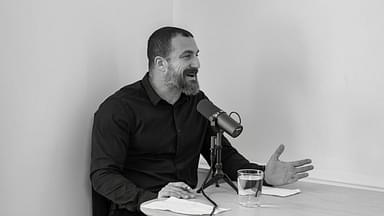Feeling sleepy and how you fall asleep have to do with your sleep-wake cycle. These cycles are mostly triggered by the chemicals in our brains. When it comes to the domain of fitness and health, Dr. Andrew Huberman, with his knowledge, has been helping millions across the globe with tips on how to stay healthy. In a recent podcast, he teamed up on a Journal Club with Dr. Peter Attia regarding the topic ‘Effects of Light & Dark on Mental Health & Treatments for Cancer.’
In one of the podcast’s segments, Huberman discusses sunrise and sunset, circadian rhythm, and midday light. He says there are four types of light one needs to see every 24 hours for optimal health. Huberman starts with the evolutionary connection that single-cell organisms, humans, dogs, rabbits, and everything in between have in common, and that is a minimum of two cone opsins.
One of the opsins responds to short-wavelength light, aka blue light. The other responds to longer-wavelength light that is orange and red. It’s a comparison mechanism in these cells of the eye neurons. They compare the contrast between blues and oranges, or sometimes blues, reds, and pinks, which are also all long-wavelength lights.
Huberman further mentions that there are two times in a day when the sky is augmented with blue, orange, pink, and red, and what’s known as low-solar-angle sunlight at sunrise. In the evening, these cells are uniquely available. Hence, it is easy to trigger the existence of those wavelengths of light early in the day. These cells have two cone photopigments. And they represent how much blue, red, or orange light is there. The subtraction between those two triggers them to fire the signal off to the circadian clock of the brain.
“That’s why I say look at low-solar-angle sunlight early in the day. What that does is what we call as phase advances the clock.”
Explaining in layman’s language, Huberman shares an example about pushing your kid on a swing. Imagine that the swing is a little bit longer than twelve hours. Hence, when we stand closer to the kid, the kid swings back, and the other person gives it a push. Here, you’re shortening the period; you’re not allowing the swing to come up. This is the same as what happens when you look at morning sunlight; you’re advancing your circadian clock.
“You’re making it such that you will want to go to bed a little bit earlier and wake up a little bit earlier the next day.”
In the evening, when you view low-solar-angle sunlight, which is the evening setting sun, Huberman says that we do the exact opposite. An individual phase delays the clock, making you stay up a little later and wake up a little later. These two signals average so that your clock stays stable.
He continues by stating that one has to make sure they don’t drift and that they’re not waking up earlier every single day. Nor is one going to sleep later every single day. This is why it’s important to view low-solar-angle sunlight in the morning and again in the evening. One needs to continue this as often as possible.
Andrew Huberman states that midday light helps in an individual’s well-being but plays no role in the sleep-wake cycle
The midday sun contains bright light, but you see it as white light. This contains all of those wavelengths at equal intensity, so in the middle of the day, it is the so-called circadian dead zone. The bright light triggers the activation of the other opsin, melanopsin, which helps mood and increases feelings of well-being. It holds some other consequences, but you can’t shift your circadian clock by viewing the sun in the middle of the day.
“In biological terms, you get nothing. Looking at sunlight in the middle of the day is great, but it’s not going to help anchor your sleep-wake cycle.”
Moreover, during the interview, Huberman tells Dr. Peter that it is always better to get the morning light. However, if you miss a day, you’ll want to get twice as much light in your eyes the next morning. The reason to do this is to better do it in the morning as opposed to the evening, although both would be best.
“Your retina is very insensitive to light early in the day; you need a lot of photons to trigger this mechanism early in the day. As the day goes on, retinal sensitivity increases and it takes very little light to shift your circadian clock late in the day.”
Therefore, he mentions that it is best to view low-solar-angle sunlight later in the day. And to get as much bright light in our eyes as we safely can, ideally from sunlight throughout the day. However, if you can’t do that, Huberman recommends investing in one of those sad lights. He suggests using Tuo, the light bulb that has been developed by a biologist at the University of Washington.
“Most of the sad lamps that are out there are activating only one of the mechanisms in these cells that’s relevant and not the most relevant one. So I’m excited about what Tuo are doing.”
Those lights are not particularly expensive, and they seem to work well. An emerging study indicates that if you look at it for more than five or six minutes, it can induce mild euphoria. That’s how powerful this contrast is and what they did there in that light.
In conclusion, Huberman feels that we’re still in the early days of these Lux and sad lights, and there is more to find out, but the best way is to have this built into your laptop or phone. This way, it will make it easier for people in the future to look at bright lights for a better circadian rhythm.





